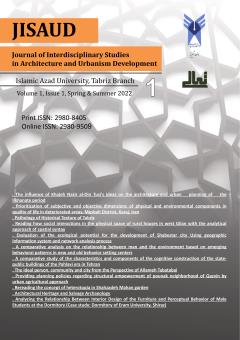The influence of Khajeh Nasir al-Din Tusi's ideas on the architecture and urban planning of the Ilkhanate period
Subject Areas :
Hannaneh FayyazMoghaddam
1
![]() ,
Lida Balilan.
2
*
,
Lida Balilan.
2
*
1 - Senior Architecture Expert, Department of Architecture, Tabriz Branch, Islamic Azad University, Tabriz, Iran.
2 - Associate Professor, Department of Architecture, Tabriz Branch, Islamic Azad University, Tabriz, Iran. (Corresponding Author)
lidabalilan@hotmail.com
Keywords: architecture, Urban Planning, thought, Khajeh Nasir al-Din Tusi, Il-khanate,
Abstract :
The architecture and urban planning of any nation is a reflection of the thoughts of the people who are influenced by the philosophical thoughts of the thinkers of their era, which will not be possible to understand except by studying the works and the historical period of their lives. The seventh and eighth centuries AH is the era of flourishing Iranian architecture after the Mongol invasion subsided and the formation of an Il-khanate government. One of the most influential people of this period is Khajeh Nasir al-Din Tusi. This article tries to explain the architectural and urban planning features influenced by these ideas with the aim of carefully studying the artistic and geometric concepts of Khajeh and expressing the ideas originating from his philosophical and theological foundations. This study also seeks to answer questions such as how the impact of his ideas in the architecture of this period by examining the writings and architectural works. The results of this research emphasize the connection between the architecture and urban planning with the philosophical and geometric ideas of him. The type of influence of these ideas is such that Khajeh was able to combine the three issues of politics, science and religion with the help of his position, and in addition to the theoretical use of theological and philosophical ideas in the form of an ideal city, he also directly used from sciences such as mathematics, geometry and astronomy to be effective in the construction and decoration of Il-khanate buildings and linking endowment with urban planning.
_||_

